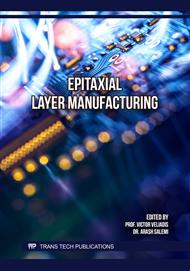p.17
p.23
p.33
p.43
p.49
p.57
p.63
p.69
p.75
High-Quality SiC Crystal Growth by Cooldown Rate Control at Cooling Stage
Abstract:
Thermoelastic stress generated within SiC crystals during the cooling process can induce various types of dislocation defects. In this study, a newly designed cooling protocol was proposed to investigate the correlation between cooldown rate and defect formation in 4H-SiC single crystals. Three distinct cooldown rates, 10~30 °C/min, 1~5 °C/min, and less than 1 °C/min, were applied to assess their impact on the development of thermoelastic stress and resulting crystal quality. Notable variations in ingot color and surface morphology were observed depending on the applied cooldown rate. Dislocation types, including basal plane dislocations (BPDs), threading edge dislocations (TEDs), and threading screw dislocations (TSDs), were quantified through etch pit density (EPD) measurements after molten KOH etching at 600 °C for 14 minutes. The results indicate that higher cooldown rates led to an increase in BPD density due to enhanced plastic deformation, while lower cooldown rates resulted in higher TED and TSD densities, likely due to increased thermal stress. These findings demonstrate that precise control of the cooldown rate is critical for suppressing thermoelastic stress and minimizing defect densities in SiC crystal growth.
Info:
Periodical:
Pages:
75-79
Citation:
Online since:
September 2025
Permissions:
Share:
Citation:


